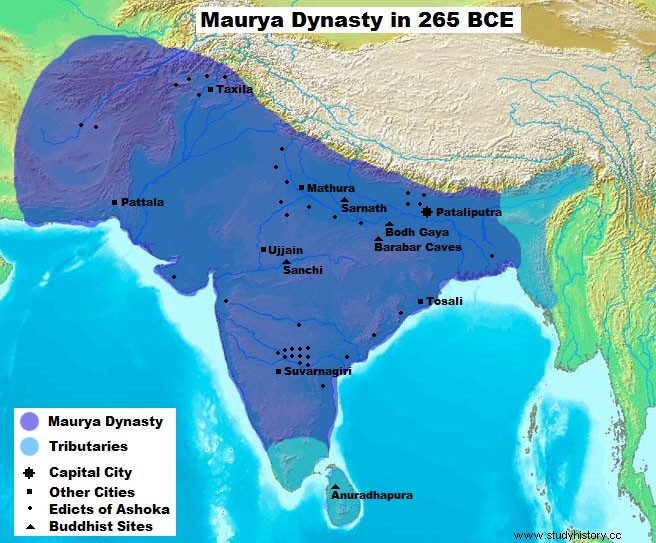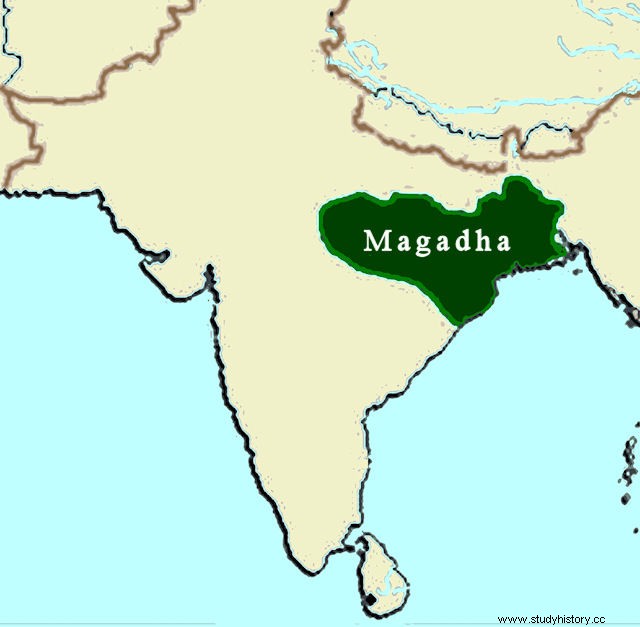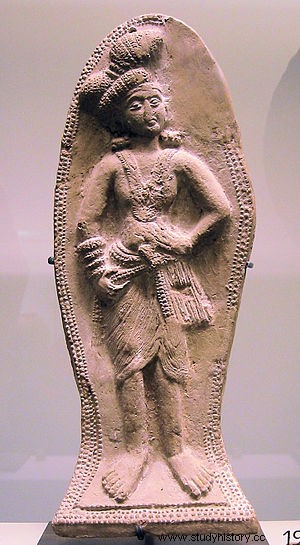The mighty Pushyamitra Shung
As long as Emperor Ashoka continued to follow the policies of his guru Chanakya, the Maurya Empire flourished and spread to touch the border of Iran in the west and Myanmar in the east. It reached the border of Tamil Nadu and Kerala in the south, including Afghanistan, Kashmir in the north, but, after renouncing arms and adopting the policy of Dhamma Ghosh in place of Bhedi Ghosh (war victory), it was created by the blood and sweat of Chanakya and Chandragupta Maurya. Seeing the vast Maurya Empire, it started falling in panic. It is said that he also disarmed his soldiers and engaged them in the promotion of Buddhism and non-violence. India from the present Pakistan, Afghanistan to Iran border across the Indus river had become almost Buddhist.

But Ashoka's non-violence had given rise to violence in his own house. His fifth wife, Tishyarakshita, beheaded Karuvaki's son and crown prince Kunal. Ashoka spent all his treasury on the promotion of Buddhism, Buddhist monasteries and Buddhist sangha. The treasury was getting empty, but the money-hungry of Buddhists, Buddhist monasteries and Buddhist associations was increasing. The plight of the Maurya Empire and the empty treasury dissatisfied the Amatyas and one day the Amatyas were compelled to put Ashoka under house arrest and declared Kunal's son Samprati as the king. He died under house arrest in 232 BCE.
Due to Ashoka's policy of peace and non-violence, the kings and satraps under him started revolt. He also ordered his descendants and subordinate kings, satraps to follow the policy of Dhamma Ghosh in place of Bhedi Ghosh. Therefore, as soon as Samprati became the king, the central control ended and he declared his independence. Bhagsen of Kabul made his own state up to the Indus. Virasen became an independent ruler in Gandhara. Historian Hemchandra Roy Chowdhury writes, "The Mauryan Empire disintegrated after the death of Ashoka and was divided among his sons. Some of the outer provinces left the empire, the process of disintegration of the state was made even more rapid by the people of the emperor's family. The poor condition of the empire encouraged the Yavanas to regroup. The Yavan (Greek) king Antiochus I of Syria defeated King Bhagasena of Kabul and took control of the kingdom."
Not only Magadha Empire but also Magadha was in bad condition

The Magadha Empire was not only a victim of strategic and economic predicament, but it had also become a victim of social and religious predicament. Along with the rust in the weapons, the arms of the Kshatriyas also got rusted. The contact of the Mauryan kings with the army was completely broken. The soldiers were desperate, disappointed and dissatisfied. The armed soldiers were forced to wander unemployed. Hindus were angry and Brahmins were poor because of Ashoka's excessive inclination towards Buddhism and ban on yagyas, then Buddhist monks and Buddhist monasteries became rich. The Mauryan power was completely in the grip of the Buddhist sanghas. Buddhist monasteries had authority over the local government. During the time of the tyrannical Maurya king Shalisuk, there was a lot of atrocities on the Hindus, especially the Brahmins. At this time Buddhist monasteries had crossed all limits. They used to remove the idols of deities from the temples and put the statue of Buddha. By the rule of Brihadratha Maurya, the Maurya Empire had completely disintegrated. The Maurya Empire was more or less confined to Magadha.
The mighty warrior Pushyamitra Shung

Brihadratha Maurya an anti-people and intelligible 1 That is, he was a wise king. One day he was passing through the forest. Suddenly a lion attacked him. He stood irritable, but before the lion reached the king, a young man came in the middle of the lion with a single stroke of the sword and cut the lion into two pieces. The name of that brave warrior was Pushyamitra Shung 2 , Brahmin by birth, Kshatriya by action. Its family Mauryan priest 3 Used to be but now he was unemployed. Brihadratha was pleased and made him his vice-general. Soon he became the commander of the Maurya army by his might. The Maurya army whose swords and arms were rusted.
Yavan's invasion of India
The Yavana army (Greek soldiers) had crossed the Indus and took control till Haryana, but the Maurya king was busy singing the song of Dhamma Ghosh in place of Bhedi Ghosh. It was unbearable for the brave warrior Pushyamitra Shunga that foreign Yavanas were being entered inside the country and Magadha's army remained dormant. He talked to the army. The army supported him and then the military preparations started. The unarmed and useless soldiers were left in disarray and the tremors of weapons started reverberating from the military exercises. After a few days, the army was ready to parade in front of the king, from passive to active and fit. Commander Pushyamitra Shunga called King Brihadratha to see the parade of the army. Seeing his armed army, the non-violent Brihadratha turned red with anger.
She screamed, "What is all this?"
“Yavans have entered India, the army is ready to stop them,” replied the commander.
He roared and said, “We believe in Dhamma Vijay not Shastra Vijay. With whose permission did you organize a military organization?"
Pushyamitra fearlessly replied, "When it comes to the security of the nation, the brahmin does not wait for anyone's orders!"
Enraged by this answer, the brainless Brihadratha pounced on Pushyamitra; Pushyamitra, defending himself, took out his sword and cut his neck.
Pushyamitra's roaring voice echoed, "" Neither Brihadratha was important, nor Pushyamitra is important. Important is the Magadha Empire! Our motherland is important!! Are you ready to shed blood to protect the nation?"
The single voice of the soldiers reverberated with full humour, "Yes, we are ready to shed the blood of enemies to protect our nation!"
“So I promise that I will spend my whole life as a soldier of Magadha Empire to protect Magadha. I have no aspiration to be king. I will do my work as the commander of Magadha for life."
Pushyamitra Shunga, the protector of Magadha
As soon as Pushyamitra took the rule of Magadha in his hands, there was a wave of happiness among the people along with the army. The subjects were troubled by their brainless, cowardly king. At all times, there was a feeling of insecurity and fear of foreign invasion. Now he became restless because of the power coming in the hands of the mighty warrior. Historians write, "The change of power was accepted by the public, because the later Mauryas became tyrannical and the Yavanas were unable to stop the attack and protect the dignity of Magadha's military power."
Pushyamitra first strengthened the military power as soon as he took the rule in his hands. Arsenal reinstated mercenaries. To strengthen the economic condition, unnecessary grants being given to Buddhist monasteries and associations were stopped. Unnecessary political interference of Buddhist monasteries was also ended, although some Buddhists were given cabinet 4 also given a place. In place of the Buddha statues that were forcibly kept in the temples, gods and goddesses were again established. Yagya and worship in temples resumed. Forcibly or reluctantly, the Buddhist people again became the followers of Vedic religion. Pushyamitra Shunga issued an order making it mandatory for all Hindus to have a vaccine on the head. Panchayat system was again restored at the level of local government.
Anti Magadha Conspiracy of Political Buddhists
Political Buddhists, who had become in the habit of eating free cream, were very angry due to the change of power and the closure of unnecessary grants to Buddhist monasteries and sanghas, ending interference in power. The Buddhist monastery was becoming the arena of politics. The rebellious voice of political Buddhists also started resonating. At the same time, the Yavana ruler Demetrius planned an attack on Magadha. His commander, Minander, reached Taxila, which had already become the political arena of Buddhists.
This was the famous Taxila where till a few decades ago people from all over the world used to come to take education. Where, with the help of the students, Chanakya and Chandragupta had not only expelled the Yavanas out of India, but had established the great Maurya Empire by tying the whole of India together. The same Takshashila had now become a haven for Buddhist fanatics, politics and anti-India conspiracy. It is said that here plans were made for the victory of Yavanas against the Magadha Empire of the later Mauryas and there used to be a conspiracy. The commander of Yavana Demetrius, Minander, reached Taxila and made a proposal to the political Buddhists, if they would help the Yavanas in the conquest of India, then he himself would adopt Buddhism. He was also lured with a lot of money and facilities.
Political Buddhists supported this proposal of the Yavanas, and within a few days, the echo of this proposal was heard in Buddhist monasteries up to Pataliputra within India. Then the Buddhist monks coming from Yavan region who used to bring weapons hidden inside their clothes gradually started living in hiding in various Buddhist monasteries of India. After all the preparations, Demetrius divided his army into two parts and entered India. One part was to be led by Demetrius himself, who was to reach Pataliputra via Chittor. The second part was to reach Pataliputra via Mathura, Panchal under the leadership of Commander Minander. The Buddhist monasteries gave full support to the Yavanas. The Yavana soldiers disguised as Buddhist monks in the Buddhist monasteries were making their way and meeting the Yavana army. Demetrius's army managed to reach Chittor and Minander's army to Mathura.
Pushyamitra Shunga attacks the conspirators and the Yavana army
When Pushyamitra came to know about this conspiracy along with the attack of the Yavanas, he became furious. The Yavana soldiers had reached the Buddhist monasteries of Pataliputra in the guise of a Buddhist monk. He had kept his army ready for war with the Yavanas, as well as he also started searching Buddhist monasteries. In the Buddhist monasteries where the Yavana soldiers were found hiding, in addition to beheading the Yavanas, political Buddhists were also beheaded and the Buddhist monasteries were demolished. Searching Buddhist monasteries, he proceeded with the army and clashed with the Yavanas.
Here his son Vidisha was succeeded by Agnimitra Vidarbha 5 After attacking Yajnasen defeated it and merged it into Magadha Empire and then started operating Magadha from here itself. On the other hand Pushyamitra's army started to drive away the Yavanas. A terrible struggle ensued. After about a year of continuous struggle, Pushyamitra Shunga pushed the Yavanas back from Arakosia. He reached Taxila and punished the traitor political Buddhists and restored the glorious dignity of Taxila by destroying the Buddhist monasteries. He announced that whoever beheaded the anti-India traitor Buddhists who supported the Yavanas would be rewarded.
According to Yavana sources, Pushyamitra Shunga had pushed the Yavanas to Bactria, but after becoming the king of Minander before 165-60 AD, the Yavanas again took control of Arakosia, Gandhara and western Punjab, but they crossed the Indus during Pushyamitra's lifetime. Couldn't show the courage to do it.
Hindu Rashtra Reconstruction of India
Pushyamitra Shunga had again united the entire North-North-West and East India. After conquering the Greeks, Shunga returned to Magadha by performing Ashwamedha Yagya and united the Mandals and established the most powerful empire in the then world. The Indian states of the south had long ago become independent from the Maurya Empire and there was a rapid return of Hindutva. Now, along with the Vedic Aryan culture, Vedic religion had also been restored in the whole of India. Pushyamitra Shunga also started the construction of Bharhut Stupa and railing of Sanchi Stupa which was completed by his sons 6 .

Pushyamitra Shunga had two Ashwamedhas in his life 7 Yagya was done. In the last days of his rule, he performed the second Ashwamedha Yagya. Maharishi Patanjali, priest of the second Ashwamedha Yagya 8 Were. The horse of this Ashwamedha sacrifice was caught by the soldiers of Minandar on the banks of the Indus river, then Vasumitra, the son of Agnimitra and the grandson of Pushyamitra, defeated him on the banks of the Indus river and drove him across the Indus. Pushyamitra Shunga ruled for 36 years.
Agnimitra, the son of Pushyamitra Shunga, was also very brave. It is said that he spread his empire to Tibet and Tibet again became a part of India. He drove the Buddhists of Tibet to China. There the Emperor of China made a treaty by marrying his daughter to Agnimitra. His descendants still write the surname "Shung" or "Chung" in China. During the reign of Shunga dynasty, many Yavanas had also adopted Bhagwat religion.
After the Sunga dynasty, the Brahmin kings of the Kanva dynasty also followed the policy of the Sungas and strengthened the Vedic religion and culture. At the same time there was a rapid rise of the Satavahanas of Andhra in the south. उन्होंने दक्षिण में वैदिक आर्य संस्कृति और धर्म को मजबूत करने के साथ साथ यवनों को मार कर अरब तक ढकेल दिया. अब ईरान से लेकर कन्याकुमारी तक पूरा भारतवर्ष हिन्दू राष्ट्र था जिसमे सिन्धु पार के कुछ बौद्ध राज्य ९ भी शामिल थे.
1. हर्षचरित में बाणभट्ट ने बृहद्रथ को प्रज्ञादुर्बल राजा कहा है.
2. हर्षचरित में पुष्यमित्र शुंग को ‘अनार्य’ कहा गया है. बौद्ध ग्रन्थ दिव्यावदान में उसे मौर्य वंश का राजा कहा गया है.
3. आश्वलायन श्रौतसूत्र में शुंगों का उल्लेख आचार्यों के रूप में मिलता है
४. दिव्यावदान का कथन है कि पुष्यमित्र ने कुछ बौद्धों को अपना मन्त्री नियुक्त कर रखा था
5. मालविकाग्निमित्र महाकवि कालीदास का नाटक है. इससे पता चलता है कि पुष्यमित्र का पुत्र अग्निमित्र विदिशा का राज्यपाल था तथा उसने विदर्भ को जीत कर अपने राज्य में मिला लिया था. कालिदास यवन-आक्रमण का भी उल्लेख करते हैं जिसके अनुसार अग्निमित्र के पुत्र वसुमित्र ने सिंधु सरिता के दाहिने किनारे पर यवनों को पराजित किया था.
6. सुप्रसिद्ध कलाविद् हेवेल का विचार है कि, ‘साँची तथा भरहुत के तोरणों का निर्माण दीर्घकालीन प्रयासों का परिणाम था जिसमें कम से कम 100 वर्षों से भी अधिक समय लगा होगा
7. अयोध्या का लेख से पता चलता है कि पुष्यमित्र ने दो अश्वमेध यज्ञ किये थे.
8. पतंजलि का महाभाष्य
9. ये बौद्ध राज्य आगे चलकर पूर्व मध्यकाल में हिन्दू विरोधी मानसिकता और मुसलमानों के हाथों आसानी से खत्म होने के कारन ईरान से अफगानिस्तान, पाकिस्तान और कश्मीर तक भारत के इस्लामीकरण और भारत में मुस्लिम आक्रमण को बढ़ावा दिया.
